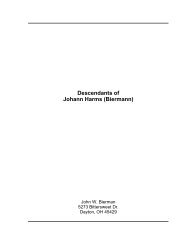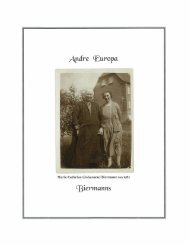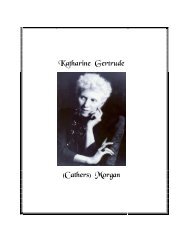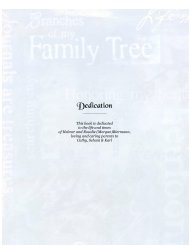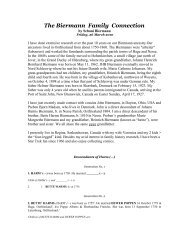A Collection of Dad's Essay's & Writings - Welcome
A Collection of Dad's Essay's & Writings - Welcome
A Collection of Dad's Essay's & Writings - Welcome
You also want an ePaper? Increase the reach of your titles
YUMPU automatically turns print PDFs into web optimized ePapers that Google loves.
- FAITH -<br />
“One life is all we have and we live it<br />
as we believe in living it.<br />
But to sacrifice what you are<br />
and to live without belief,<br />
that is a fate more terrible than dying.”<br />
here is the unimpeachable fact that Faith is considered to be many things, but for those who consider<br />
it a freedom, there can be no argument. For those who believe it to be a part <strong>of</strong> civilization is another<br />
facet <strong>of</strong> truth and those believe it to be a form <strong>of</strong> happiness, can live in security. But it is also a power,<br />
a form <strong>of</strong> aesthetics and morality. So the Christian faith must be a combination <strong>of</strong> what is spoken in<br />
the Credos, the teaching <strong>of</strong> Christ, a form <strong>of</strong> disciplined and tasteful worship combining the Liturgy,<br />
the Word and all the Sacraments. Over two thousand years <strong>of</strong> religious rites has rendered a variety <strong>of</strong><br />
forms, divisions and dissention and in 1517, the most honest and the Middle Ground was found that gave mankind a<br />
form <strong>of</strong> worship and belief that combined Christian principles with common sense, a purpose and honesty. What<br />
evolved in the previous 1500 years became the basis for the most honest form <strong>of</strong> Christianity since the Week <strong>of</strong> the<br />
Passion. What Luther achieved was the pure, the untainted, the honest and the most intelligent form <strong>of</strong> Worship and<br />
Word.<br />
What the new freedom gave, though, was also a distortion <strong>of</strong> religion and religious values that brought with it<br />
many divisions within the protesting reformers in the 16th century and in only the four major faiths within the<br />
Roman Catholic, the Orthodox, The Anglican and the Lutheran, did God and Christianity get its most honest<br />
evaluation. Only in the Lutheran Faith did Aesthetic Worship and the Teaching Word attain its perfection by<br />
combining all the elements <strong>of</strong> proper worship and clarity <strong>of</strong> thinking.<br />
At the time <strong>of</strong> the upheavals within the church in the years from 1519 onward, it was only Luther who understood<br />
and appreciated the fine hymns in the Latin Hymnody and, 15 <strong>of</strong> the 38 hymns he translated into the German<br />
language were from this source. Zwingli, Calvin and Knox ignored the whole body <strong>of</strong> these fine hymn texts and<br />
sometimes <strong>of</strong>fered crude vernacular paraphrases <strong>of</strong> the Psalms. Lutheran authors such as Gerhardt, Arnt Heermann<br />
and others <strong>of</strong>fered verses closer to Scripture when <strong>of</strong>fering new German hymns and also translated many from the<br />
Latin. But in the pre-Reformation days there were no hymns sung by the people at Mass. The use <strong>of</strong> hymns was<br />
associated with Hour Offices and the Father <strong>of</strong> Latin Hymnody was St. Ambrose.<br />
In the whole <strong>of</strong> hymnody there is little question that the best texts where those written by great poets, early<br />
theologians and men <strong>of</strong> the Middle Ages, Reformation and Renaissance. The finest music composed for use as hymns<br />
in the congregations <strong>of</strong> Lutheran parishes were those that came out <strong>of</strong> the Reformation era and the two centuries<br />
following as well as those composed in England, Germany and Scandinavia in the 18th and 19th centuries.<br />
Martin Luther, who was not only the great reformer and renewer <strong>of</strong> the ancient church, was also a man <strong>of</strong> culture<br />
who understood the pr<strong>of</strong>ound meaning <strong>of</strong> hymn texts and noted that they deserved the best musical dressing. It is<br />
true that Luther and many <strong>of</strong> the Reformation composers used tunes they heard in the taverns or love songs <strong>of</strong> the<br />
minstrels and troubadours, but he qualified it with the comment that the devil didn’t deserve all the good tunes. But it<br />
can be said that Luther not only taught the German nation to sing in church, but led the way in a significant<br />
development <strong>of</strong> German culture in general. It gave every parish congregation an opportunity to participate in the<br />
worship service in more ways than one. He regarded music as one <strong>of</strong> the greatest gifts given to man by God.<br />
In the early years, the Lutheran hymnody reflected the mystery <strong>of</strong> worship and Holy Communion and there was<br />
some liturgical conservatism and mysticism retained by reformers not only in paraments, church buildings, but in<br />
music. So Lutheranism had a sense <strong>of</strong> historical continuity as well as a high appreciation <strong>of</strong> the esthetic. Good<br />
hymnody <strong>of</strong>fers a sense <strong>of</strong> reverence and honor due to the Almighty, rather than secularizing it by stooping to the<br />
lowest common denominator in verse and music. Hymnody serves the Almighty, not the secular pop scene. The<br />
hymnody should also complement the Liturgy and Scripture.<br />
Certainly the most famous <strong>of</strong> all Lutheran composers was Johann Sebastian Bach, (1685-1750) whose faith was<br />
deeply rooted in the faith <strong>of</strong> the great reformer. His greatest sacred choral works such as the “St. Matthew Passion”,<br />
the “Christmas Oratorio” and the “Mass in B Minor” were only a part <strong>of</strong> his output with over 200 cantatas used at<br />
church services. Also there was a huge collection <strong>of</strong> organ pieces, with the famous “Well Tempered Klavier”, the<br />
Brandenburg concertos, the four orchestral suites and a wide selection <strong>of</strong> instrumental works. Bach was a<br />
conservative Lutheran with a great respect for the teachings <strong>of</strong> Martin Luther and understood the Lutheran doctrines<br />
<strong>of</strong> the church and the communion with Christ and the ideals <strong>of</strong> the church. He understood the Church Year and, with<br />
great care and devotion, created Cantatas for every Sunday in the calendar <strong>of</strong> the church. Such a very large output <strong>of</strong><br />
his music is devoted to the church as well exemplified by his 200 cantatas as well as his organ compositions, motets<br />
and Passions. There were many Reformation hymn tunes that apparently are by unknown composers whose names<br />
have disappeared through carelessness or lack on interest in preserving their names. But many <strong>of</strong> these are found in<br />
various books and listed in the Lutheran Book <strong>of</strong> Worship (LBW) with an indication <strong>of</strong> their original source. These are<br />
noted as from Gesangbuch in Augsburg, Berlin, Mainz, Munster, Nurnberg and other cities in Germany.



